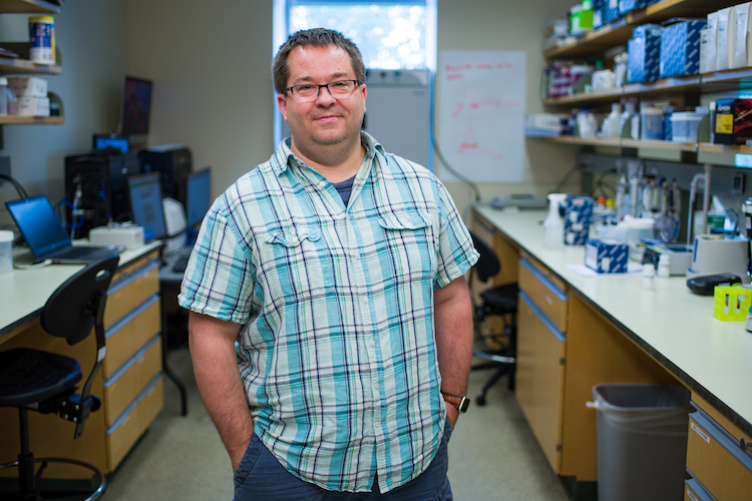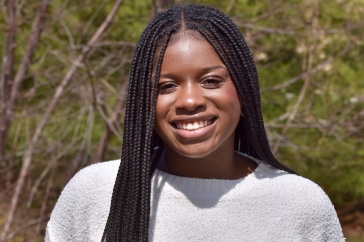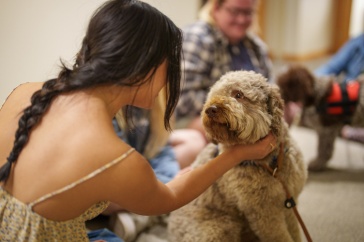
Editor's Note: This is the latest installment in a series featuring UNH faculty telling their stories in their own words.
Matthew MacManes, assistant professor of genome-enabled biology
"When I graduated from high school, I didn’t know what I wanted to do, so I decided to be an exchange student. I got involved with the Rotary International exchange program and spent a year in Bolivia. After that I still didn’t know what I wanted to do. I was 19 years old. My mother was a nurse, so I thought maybe I should become a nurse. I got my associate's degree and my nursing license, and for the next three or four years, I worked in inpatient psychiatry, in the ER and ICU. Still, I wondered if that was what I wanted to do for the rest of my life.
So, I thought maybe I’d become a physician, and I started down that path. By then I was married and had two kids. We were living in upstate New York, where I grew up, and I started looking at schools. I ended up at the University of Michigan. We lived in university housing, surrounded by all these international families, and it was wonderful. My kids learned Korean, French, Arabic. I was an undergraduate on a premed track, and everything was going great. Then I took a class on woody plants.
It was an elective. Every week, we spent 4 to 5 hours wandering around the woods, and it wasn’t long before I said, ‘Now, I know what I want to do. I want to be outside, learning about nature.’ The next big change was about to happen.
I was still working as a nurse; it was paying the bills. I’d go to school Monday through Friday and work Saturday and Sunday. So, while all the other students were going out and having fun, I was working in an emergency room, taking care of my young and growing family.
I knew as soon as I graduated that I wanted to go on to grad school. I applied to UC Berkeley, UC Davis and Emory. I was a good student, but I didn’t know what my chances were of getting in. Then I got into Berkeley. We packed up our little apartment and rented a giant U-Haul. My wife followed in the van — now we had four kids — and we drove from Michigan to California. Once again, we lived in family housing, and it was a great experience. It was also the only thing we could afford. The kids had friends from all over the world; some of them didn’t speak English, but it didn’t matter; they just played.
During my first summer at Berkeley, my advisor, Eileen Lacey, asked me what I wanted to do for a project, and I said I didn’t know. She said, ‘Just go out to the desert. There’s lots of cool stuff there. Just see what you can see.’
What I found was truly incredible — a whole group of mammals that, amazingly, could survive without water. I was enthralled and basically every month for the next five years, we packed up the kids and drove 8 to 9 hours to the desert outside Palm Springs. My wife and kids helped me with field work, and that continued for the whole time I was doing research; every time I went, they came. They were learning about nature and seeing these incredible things.
We drove back across country to New York five or six times while I was getting my Ph.D. At one point, we drove from Berkeley to Ottawa for a conference. We had six kids then. Imagine eight people in a minivan, driving 4,000 miles in eight days — it was amazing and terrible at the same time. Each day, we’d drive 8 hours and stop at a place that had a swimming pool. And we stopped at national parks along the way — Mount Rushmore, Yellowstone, Yosemite.
Now I was going to school, studying, 50-60 hours a week, and I was still working as a nurse in an ICU. On weekends, I worked the night shift. I’d transition from being an academic to taking care of a dying victim of gang violence, a patient who just received a liver transplant or someone struggling to recover after potentially lifesaving brain surgery. Then on Monday, I’d flip back to being an academic. I did that for about 10 years, seven days a week, months on end. What else was I going to do? I had a family to support.
After I graduated, I was fortunate enough to get an NIH (National Institutes of Health) postdoc at Berkeley. We were very, very lucky to be able to stay there — most of the kids were school-age; it was our home. I thought we’d have to go somewhere else for a couple of years while I did a postdoc and looked for a faculty job.
A couple of years later, in 2013, I got the job here at UNH. This was, at the same time, one of the happiest and saddest moments in my life. I had worked so hard to get to where I was about to be, but at the same time, I was taking my wife and kids away from their friends and everything they knew; it was traumatic. I rented the biggest U-Haul known to man; my wife took four kids and two cats in the van, and I had two kids in the front seat with me, and we drove to Durham. "
All those visits to the desert led MacManes to the dehydration research he has been conducting with cactus mice, tiny desert rodents that can survive both acute and chronic dehydration. MacManes recently received a $1.7 million National Institutes of Health grant to continue that work. And he still works as a nurse one or two shifts a month.
-
Written By:
Jody Record ’95 | Communications and Public Affairs | jody.record@unh.edu

















































